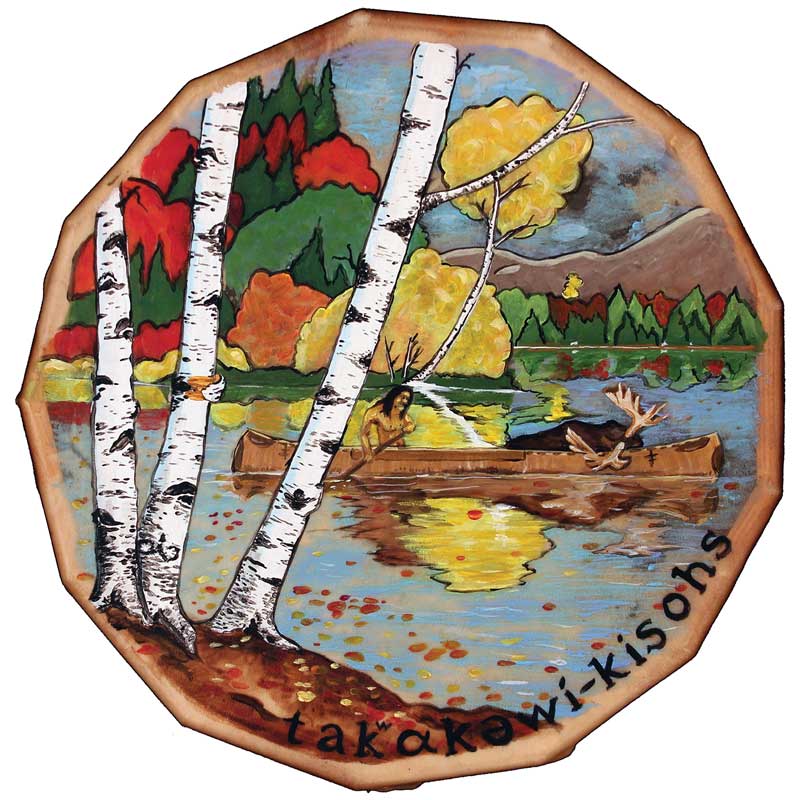

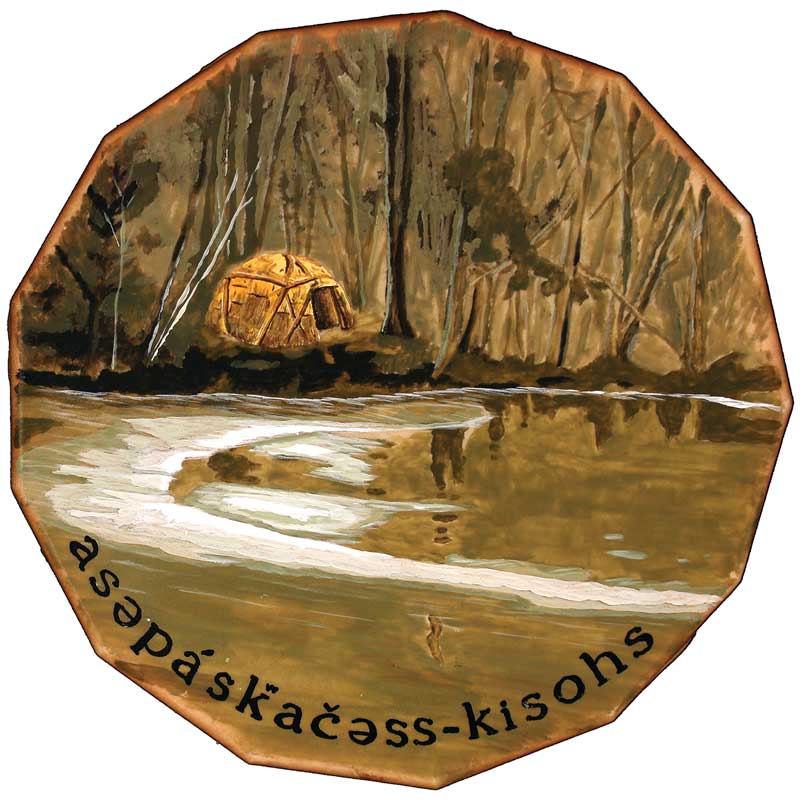
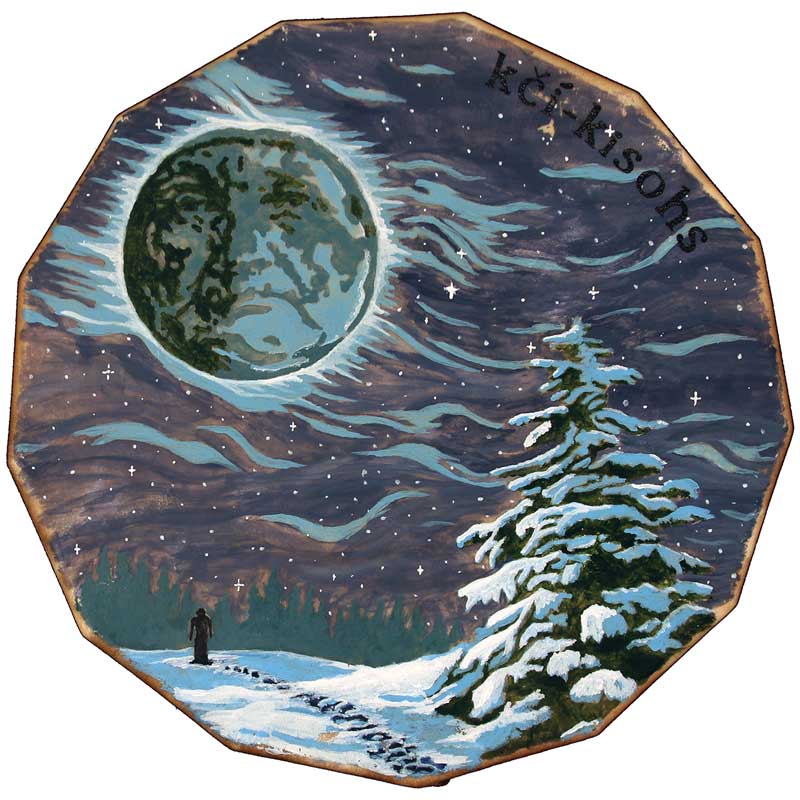
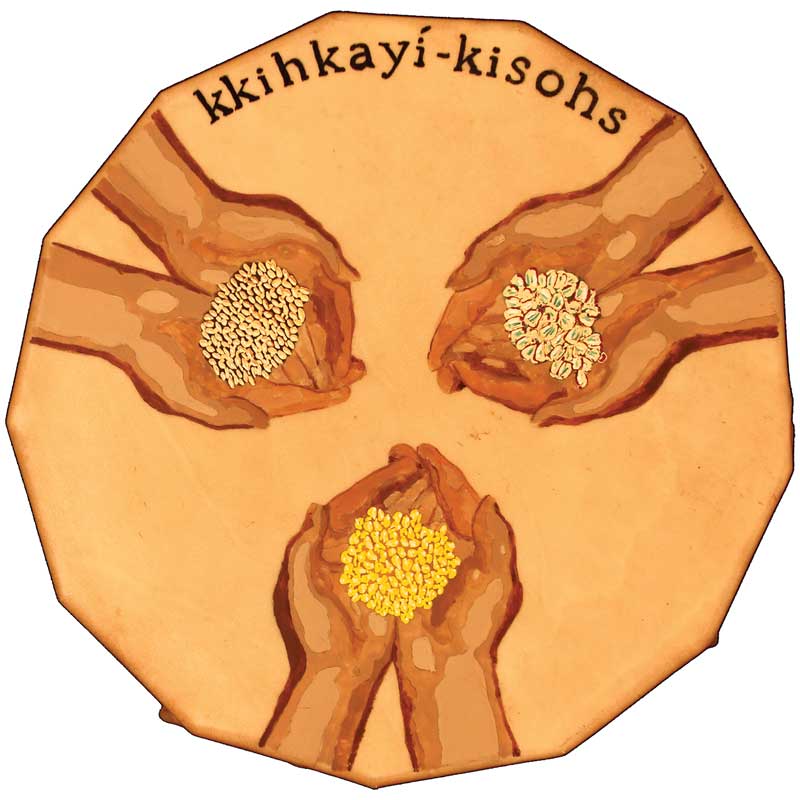
M
In painting the series, Francis sought to experience each moon as it appeared overhead, spending a month following it as it crossed the sky. He sometimes did not complete a particular piece till the very last day of the cycle. This “field work,” as he has called it, is paramount to understanding place. He takes inspiration from the immersive work of the Scottish artist Andy Goldsworthy, famed for his environmental artwork.
The moon drums eventually will be displayed in the Penobscot Nation Museum, part of a new administration building being constructed on Indian Island. When completed, the museum will offer a sampling of its holdings, which include root clubs, beaded pieces, and baskets, some of them from the Robert Anderson and Leo and Florence Shay collection currently housed at the Hudson Museum at the University of Maine. Thanks to a grant from the Quimby Foundation, the museum has been able to acquire art by contemporary Native artists.
Among Francis’s recent work are several dot paintings. Using the round point at the end of crochet hooks, which come in various gauges, he painstakingly produces perfectly circular dots in acrylic, each one separate (“they want to touch,” he explained with a laugh).
The idea for the dots came to Francis while watching Christopher Sockalexis, Tribal Historic Preservation Officer for the Penobscot Nation, flint knapping—the methodical removal of material from a stone to create arrowheads and other objects. Francis thought it would be interesting to create a painting that had “that same sensibility,” but instead of subtracting, he would add small dots.
“I wouldn’t call my style Pointillism,” Francis noted. While the work might bring to mind Australian aboriginal dot paintings, those creations are “a different kind of animal.”
Francis’s first dot painting, Welcome Home, paid tribute to the salmon returning to the Penobscot River following the removal of the Great Works and Veazie dams and the construction of a bypass channel around the Howland Dam that allowed the fish to access their historic habitat. “We consider these fish the refugees of the Penobscot River,” John Banks, director of the Department of Natural Resources for the Penobscot Nation, has said. Each dot in the painting represents one of those refugees.
In 2021 the U.S. Fish and Wildlife Service Museum and Archives commissioned Francis to create a piece for its permanent collection. He once again paid homage to the fish, using dots to represent them. The painting, Atlantic Salmon, was featured in the exhibition “American Indians and Conservation” at the Service’s National Conservation Training Center in Shepherdstown, West Virginia, last year.
Another commission came from Dr. Kimberly Christen, chair of the Digital Technology and Culture department at Washington State University. The painting’s title, Passagassawakeag, refers to the river where tribal members speared sturgeon by torchlight. Stylized wind and river currents moving in opposite directions lend a dynamism to the painting. Francis noted that if you look closely, you can see smoke drifting from the torch flames. The spear, or enikakw in the Penobscot language, “is the cultural connection” between his tribe and the sturgeon, which have also made a comeback thanks to the Penobscot River Restoration Project.
A more recent commission memorializes the grandmother of Maine attorney Sherri Mitchell, subject of one of Robert Shetterly’s Americans Who Tell the Truth portraits and founding director of the Land Peace Foundation, dedicated to the global protection of Indigenous rights. The painting is based on Mitchell’s story of the crows that appeared as her grandmother was dying and later at her interment.
Much of Francis’s art relates to the Penobscot culture. In The Great Penetrating Arrow, a painting in the Hudson Museum’s collection, he recreates a well-known Penobscot origin legend. Gluskabe, a Wabanaki hero with supernatural powers, shot an arrow into an ash tree from which sprang all the animals and people of the earth. The story underscores a Penobscot “cultural standpoint,” Francis said: “We are not on the top of a pyramid where all the other animals are beneath us: we are on the same plane as them.”
Among Francis’s most striking paintings, We Walk On; Eternally, combines his prowess as artist and knowledge as historian. He created by hand a facsimile of the notorious 1755 proclamation made by Massachusetts Lieutenant Governor Spencer Phips calling for the extermination of the Penobscot people. Diagonally across this genocidal document he stamped in large blood-red letters the Penobscot word that means “we walk on; eternally.”
The piece appeared in the Maine Historical Society’s bicentennial show, “State of Mind: Becoming Maine,” in 2020. For Francis, the painting was a way to let viewers know that not only are the Penobscot people resilient, but “we will always be here.” The piece is also a request—a plea, really—to all Maine citizens not to live in the past, but rather “to walk hand in hand with us as we all move into the future.”
Francis began his life in New Britain, Connecticut. When he was three, his mother, heartbroken by her husband’s infidelity, packed up the family, then living in Fall River, Massachusetts, and headed north toward her mother’s home on Indian Island. As Francis relates in his 2021 video Indian Time, as they crossed the Tobin Bridge, Elton John’s song “Goodbye Yellow Brick Road” came on the radio and the lyrics aligned with what he later considered to be his first trip home.
One of Francis’s earliest memories of making art dates from his time as a young student at the Indian Island School where he ran for the Andrew Sockalexis Track Club, named after the famous Olympic runner. The school published a book of poems to which he contributed several illustrations. He also encountered art through his parents, artists Cheryl and Sebastian Clayton “SC” Francis, who ran Penobscot Indian Arts.
Francis also remembers his grandmother, Beatrice Francis Phillips, braiding sweet grass for baskets. He watched in amazement as the braids “seemingly grew from her fingertips.” She was so fast, he said, “she could make grass sing.”
While an undergraduate at the University of Maine in the mid-1990s, Francis drew a tree that represented his family, the trunk being his grandmother and “all my aunts and uncles, women on the left, men on the right, as branches on the tree and their children off of those branches.” He presented prints of the drawing to his family at Christmas.

At the time, Francis was a single parent raising his daughter and didn’t have a lot of money. Inspired by the positive response to his family tree, he launched Family Tree Graphics, making designs for notecards and T-shirts which were sold in his parents’ store. The business provided much-needed income and propelled him into more creative pursuits.
Over time, Francis expanded his art practice to include graphic design, painting, photography, and video. He also attended the Intermedia Master of Fine Arts program at the University of Maine.
Francis’s studio, a log cabin in the woods behind his home in Old Town “where the magic happens,” is chockablock with art supplies, video equipment, a drum set, computers, a vinyl cutting machine, a drone, his Old Town High School diploma, and assorted ongoing projects spread across tables and chairs. His wife, Jennifer Neptune, is a brilliant basketmaker and beadworker and a registered Maine guide. Outside, a clutch of canoes lay under a coat of snow on a February day.
In one way or another Francis has been involved with most of the important initiatives and exhibitions related to the Penobscot people over the past 20 years or so. Working with filmmakers Gunnar Hansen (1947-2015) and David Westphal (1929-2020), he helped produce the 2005 ground-breaking documentary Invisible, which examines the brutal racism experienced by Indian communities in Maine and the Canadian Maritimes. He also helped the Wabanaki Studies Commission implement the 2001 Maine Native American Studies Law into K-12 schools and managed a team of teachers and cultural experts in developing curriculum. He has curated shows at the Hudson Museum, the Bangor Museum and Center for History, Harvard University, and the Abbe Museum where he serves on the Native American Advisory Committee.
Francis appears in a new documentary, Fighting Indians, which recounts the Penobscot Nation’s successful efforts to remove racist mascots from schools across Maine. His kapahse (sturgeon) drum, originally created for the exhibition “Holding Up the Sky” at the Maine Historical Society in 2019, is on display there again as part of “CODE RED: Climate Justice and Natural History Collections” (through December 30, 2023).
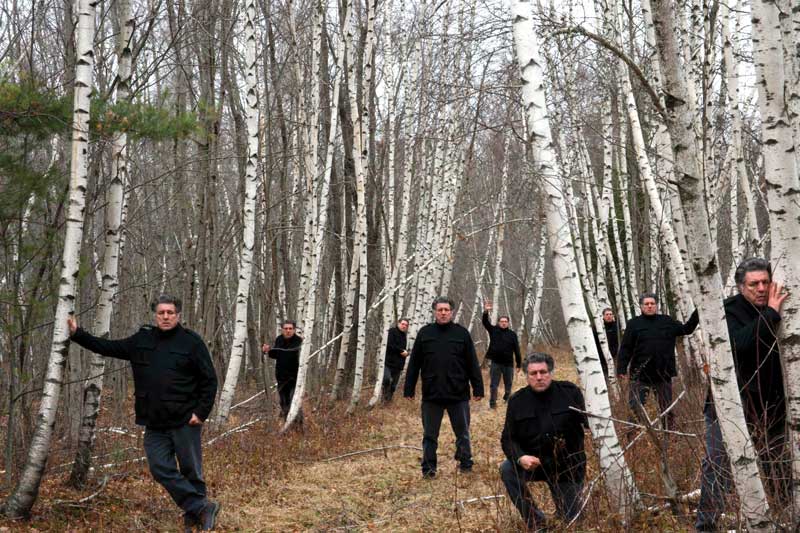
As the Penobscot Nation’s Director of Cultural and Historic Preservation and Tribal Historian, Francis spends a lot of time considering ways in which his people’s past can be interpreted and preserved. He is particularly interested in indigenous geographies: “This is our homeland and that influences a lot how I think about history and art.”
“The elements of my life are all tied together,” Francis explained, into a kind of “crazy Venn diagram.” He likes how those “little football shapes” come together to form that core idea that drives him in all his work: a sense of place.
✮
Carl and David Little’s The Art of Penobscot Bay will be out in the fall from Islandport Press.
For More Information:
You can see more of Francis’s work on his Facebook page and find his videos on YouTube. He also shows his work at the Wabanaki Winter Market. The Wells Reserve at Laudholm Farm features several of his interpretive panels related to early Native visitors to the area.






